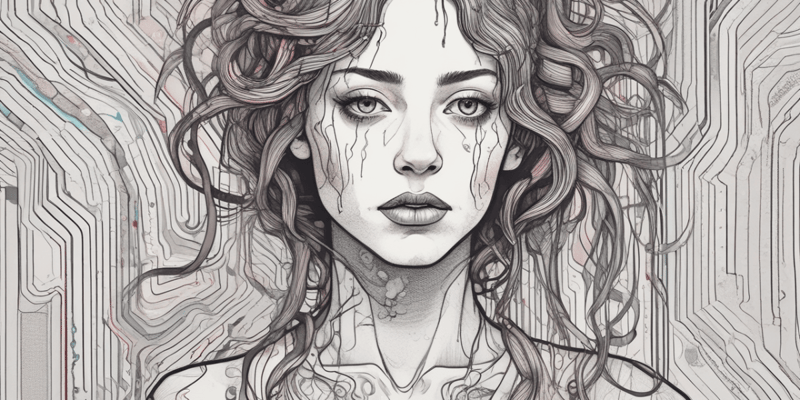16 Questions
What percentage of the general population experiences psychotic symptoms?
5%
What is the primary characteristic of disorganised thinking/speech in psychosis?
Jumps in logic and following many trains of thought
What is the name of the disorder that features at least one delusion for at least one month, with normal behaviour otherwise?
Delusional disorder
What is the typical age range for the onset of schizophrenia?
Early adulthood or adolescence
What is the primary difference between schizophrenia and schizophreniform disorder?
Duration of symptoms
What is the name of the disorder that features psychotic symptoms alongside a major mood disorder?
Schizoaffective disorder
At what age is the onset of schizophrenia very rare?
Under 10
What is the most common type of hallucination?
Auditory
What is the term for reduced self-motivation in psychotic symptoms?
Avolition
What is the ratio of prevalence rates of schizophrenia in men compared to women?
3:2
Who developed the concept of dementia praecox in 1898?
Emil Kraeplin
What is the increased risk of schizophrenia in children of two affected parents?
25-30%
What is the dopamine hypothesis of schizophrenia?
Excessive dopamine function
What is associated with poorer outcomes in schizophrenia?
Enlarged ventricles
What is impaired in schizophrenia, according to research?
All of the above
Who is attempting to address the overfocus on chronic examples from hospital settings in schizophrenia research?
Patrick McGorry
Study Notes
Psychotic Symptoms
- Delusions: can be bizarre or non-bizarre, with persecutory delusions being the most common type
- Other types of delusions: referential, grandiose, erotomanic, nihilistic, somatic
- Hallucinations: auditory hallucinations are the most common type, with voices being the most common auditory hallucination
- Disorganised thinking and speech: involves jumps in logic, clanging, tangentiality, flight of ideas, derailment, incoherence, and increased pressure of speech
- Abnormal or disorganised motor behaviour may also be present
- Negative symptoms: a cluster of psychotic symptoms including avolition, alogia, anhedonia, and asociality
Brief Psychotic Disorder (BPD)
- Requires at least one of: delusions, hallucinations, disorganised speech/thinking
- Specifiers for BPD: with or without marked stressors, and with post-partum onset
Delusional Disorder
- Features at least one delusion for at least one month
- Behaviour remains normal aside from delusions
Schizophreniform Disorder
- Presence of delusions, hallucinations, and/or disorganised speech/thinking for at least one month but less than six months
Schizophrenia
- Presence of psychotic symptoms experienced for the majority of a one-month period, with symptoms present for at least six months
- Functioning is impaired compared to pre-onset
Schizoaffective Disorder
- Presence of more than two psychotic symptoms alongside a major mood illness
- Delusions or hallucinations must be experienced for at least two weeks in the absence of a mood disorder episode
Schizophrenia Epidemiology
- Most common in early adulthood or adolescence
- Females tend to have a later age of onset, suspected to be due to hormones
- Onset is very rare under 10
- Increased rate of schizophrenia around menopause
- Higher prevalence rates of schizophrenia in men compared to women (3:2) and in migrants and developing countries
Associated Features of Schizophrenia
- Stigma
- Depression and suicide
- Anxiety
- PTSD, either from psychosis or from treatment
- Substance use
- Poor quality of life
- Earlier death, either from illness or treatment
History of Schizophrenia Research
- 1860: Benedict Augustine Morel developed dementia precoce, a first attempt at classification/description of schizophrenia
- 1898: Emil Kraeplin developed dementia praecox, emphasizing early onset and deteriorating course
- 1911: Eugen Bleuler named schizophrenia and noted that it didn't necessitate early onset and didn't always worsen with time
- 1959: The first DSM was published, including first-rank symptoms
- 1972 and 1974: The US-UK Cross-National Project and WHO Multi-Centre Collaborative Study aimed to address un-standardised criteria of schizophrenia
- 1980: The DSM-3 was published, with updated schizophrenia criteria with exclusion and inclusion rules
Current Research and Genetics
- Patrick McGorry is a current schizophrenia researcher aiming to study first-episode patients
- Need to study psychotic symptoms individually, not just as a whole
- Significant genetic component in the development of schizophrenia
- At least 100 genes involved in schizophrenia
- Dopamine hypothesis of schizophrenia proposes excessive dopamine function, but no evidence for increased levels of dopamine
This quiz covers the different types of psychotic symptoms, including delusions, hallucinations, and disorganised thinking and speech.
Make Your Own Quizzes and Flashcards
Convert your notes into interactive study material.
Get started for free



